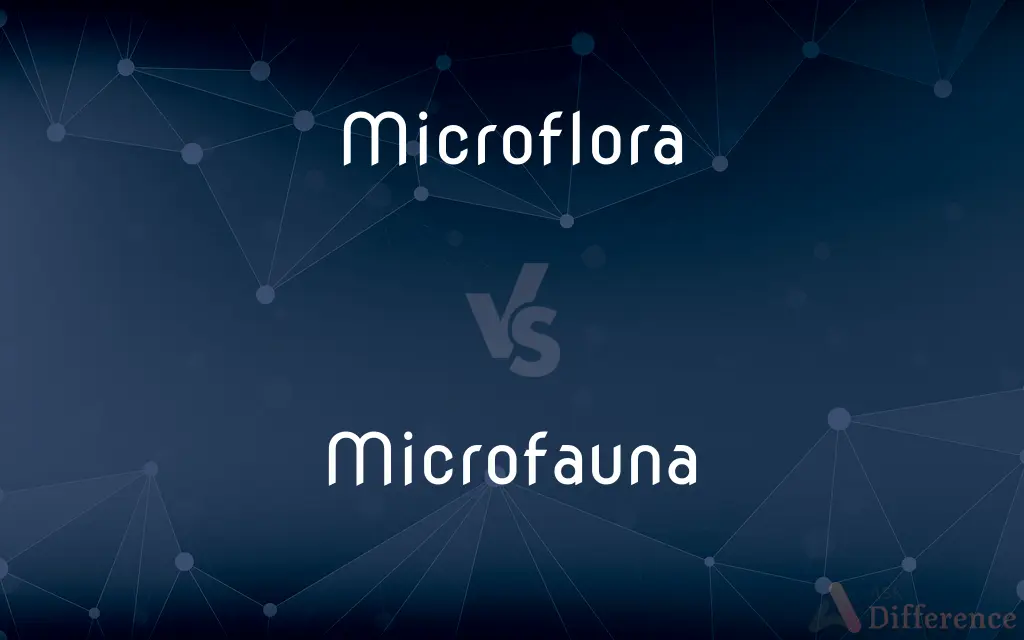Microflora vs. Microfauna — What's the Difference?
Edited by Tayyaba Rehman — By Urooj Arif — Updated on April 8, 2024
Microflora refers to microscopic plants and bacteria, essential for ecosystems, while microfauna encompasses tiny animals, vital for nutrient cycling.

Difference Between Microflora and Microfauna
Table of Contents
ADVERTISEMENT
Key Differences
Microflora encompasses microscopic plant-like organisms and bacteria, playing crucial roles in nutrient cycling and ecosystem health. These include algae, fungi, and photosynthetic bacteria, which contribute to the decomposition of organic material and the production of oxygen. On the other hand, microfauna consists of tiny animal organisms, including protozoans and small invertebrates, which are key players in soil and water ecosystems, contributing significantly to nutrient cycling and the decomposition process. They serve as a critical food source for larger organisms and are involved in the breakdown of organic matter, aiding in the maintenance of environmental balance.
Microflora, such as bacteria and fungi, are essential for breaking down complex organic substances, thereby enriching the soil and water with nutrients necessary for plant growth. These microorganisms also play a pivotal role in the carbon and nitrogen cycles, influencing climate and ecosystem dynamics. Whereas, microfauna, such as nematodes and rotifers, are primarily involved in the control of microbial populations through predation. This control mechanism helps maintain ecological balance and ensures the proper functioning of biogeochemical cycles, affecting the availability of nutrients in various environments.
Microflora often forms symbiotic relationships with plants, enhancing nutrient absorption and providing defense against pathogens. This interaction is vital for the health and productivity of agricultural systems. Conversely, microfauna, through their feeding activities, can influence the physical properties of soil, such as its porosity and aggregate stability, thereby affecting water infiltration and root penetration. Their role in the soil ecosystem underlines the importance of biodiversity for sustainable agricultural practices.
In terms of research and industrial application, microflora has been extensively studied for its potential in biotechnology, including the development of biofuels, waste treatment, and the production of pharmaceuticals. The manipulation of these microorganisms offers promising solutions to energy, health, and environmental challenges. Microfauna, while less explored, has shown potential in ecological assessments and bioindication, providing insights into the health of ecosystems and the impact of environmental stressors.
The study of microflora is critical for understanding microbial ecology and the impacts of microorganisms on climate change, through their roles in greenhouse gas emissions and carbon sequestration. Microfauna research, although less prevalent, is equally important for ecosystem management and conservation, offering a window into the intricate interactions that sustain life on Earth.
ADVERTISEMENT
Comparison Chart
Definition
Microscopic plant-like organisms and bacteria
Tiny animal organisms
Role in Ecosystem
Decomposition, nutrient cycling, oxygen production
Nutrient cycling, decomposition, control of microbial populations
Applications
Biotechnology, biofuels, pharmaceuticals
Ecological assessments, bioindication
Symbiotic Relationships
Common with plants
Less common, mostly affect soil properties
Research Focus
Climate change impact, microbial ecology
Ecosystem health, biodiversity
Compare with Definitions
Microflora
Microscopic plants and bacteria.
Microflora like cyanobacteria play a pivotal role in nitrogen fixation.
Microfauna
Tiny animal organisms.
Microfauna like rotifers play a crucial role in aquatic ecosystems.
Microflora
Symbiotic relationships with plants.
Microflora form symbiotic relationships that enhance plant nutrient uptake.
Microfauna
Less explored in biotechnology.
Microfauna hold potential in ecological assessments but are less studied than microflora.
Microflora
Decomposers in ecosystems.
The microflora in soil decompose organic matter, releasing nutrients for plants.
Microfauna
Nutrient cycling contributors.
Soil microfauna contribute to nutrient cycling by breaking down organic matter.
Microflora
Climate change impacts.
Research into microflora focuses on their role in carbon sequestration.
Microfauna
Soil structure influencers.
The activity of microfauna affects soil porosity and aggregation.
Microflora
Biotechnology applications.
Microflora are used in the creation of antibiotics and biofuels.
Microfauna
Bioindication for ecosystem health.
Microfauna diversity is an indicator of soil health.
Microflora
Microscopic plant life, especially the bacterial colonies found in the gut of normal, healthy animals and humans.
Microfauna
Microfauna (Ancient Greek mikros "small" + New Latin fauna "animal") refers to microscopic animals and organisms that exhibit animal-like qualities. Microfauna are represented in the animal kingdom (e.g., nematodes, small arthropods) and the protist kingdom (i.e., protozoans).
Microfauna
Microscopic or very small organisms, such as protozoans, that live in soil or benthic sediments.
Microfauna
The smallest of the faunal size divisions, including mainly microorganisms but also sometimes applied to the tiniest species of animal groups such as ticks, insects, etc.
Common Curiosities
What are microfauna?
Microfauna are tiny animals that play significant roles in nutrient cycling and ecosystem health.
Can microflora and microfauna coexist in the same environment?
Yes, they coexist and interact within ecosystems, contributing to ecological balance and diversity.
How do microflora contribute to the ecosystem?
They decompose organic material, enrich soil and water with nutrients, and participate in carbon and nitrogen cycles.
What are microflora?
Microflora are microscopic plants and bacteria essential for ecosystem functioning and nutrient cycling.
How do microfauna affect ecosystems?
Through nutrient cycling, decomposing organic matter, and controlling microbial populations.
Why is the study of microflora important?
It's crucial for understanding microbial ecology, biotechnology applications, and impacts on climate change.
What is the significance of microfauna in research?
Microfauna are important for understanding ecosystem health, biodiversity, and the effects of environmental stressors.
Do microflora have symbiotic relationships?
Yes, especially with plants, enhancing nutrient absorption and offering protection against pathogens.
What applications are microflora used for in biotechnology?
They're used in developing biofuels, waste treatment, and pharmaceuticals.
How do microfauna influence soil properties?
Their feeding activities can alter soil porosity and aggregate stability, affecting water infiltration and root growth.
Can microfauna be used in ecological assessments?
Yes, they serve as bioindicators for the health of ecosystems.
How can understanding microflora and microfauna contribute to sustainability?
It can inform practices that enhance biodiversity, soil health, and ecosystem resilience, crucial for sustainable agriculture and conservation efforts.
How do microflora affect climate change?
Through their roles in greenhouse gas emissions and carbon sequestration.
Are microflora and microfauna found in all ecosystems?
Yes, they are ubiquitous in both aquatic and terrestrial ecosystems, playing vital roles.
What makes microfauna less explored than microflora?
Microfauna's roles in ecosystems are less directly connected to biotechnological applications, making them less studied.
Share Your Discovery

Previous Comparison
Ingenious vs. Ingenuitive
Next Comparison
Drapes vs. CurtainAuthor Spotlight
Written by
Urooj ArifUrooj is a skilled content writer at Ask Difference, known for her exceptional ability to simplify complex topics into engaging and informative content. With a passion for research and a flair for clear, concise writing, she consistently delivers articles that resonate with our diverse audience.
Edited by
Tayyaba RehmanTayyaba Rehman is a distinguished writer, currently serving as a primary contributor to askdifference.com. As a researcher in semantics and etymology, Tayyaba's passion for the complexity of languages and their distinctions has found a perfect home on the platform. Tayyaba delves into the intricacies of language, distinguishing between commonly confused words and phrases, thereby providing clarity for readers worldwide.














































